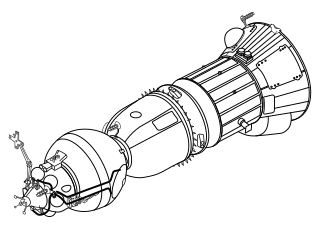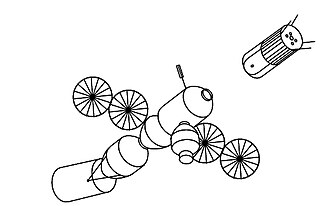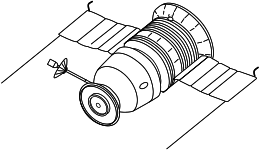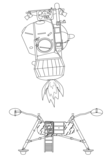
The Soyuz programme is a human spaceflight programme initiated by the Soviet Union in the early 1960s. The Soyuz spacecraft was originally part of a Moon landing project intended to put a Soviet cosmonaut on the Moon. It was the third Soviet human spaceflight programme after the Vostok (1961–1963) and Voskhod (1964–1965) programmes.

A trans-lunar injection (TLI) is a propulsive maneuver, which is used to send a spacecraft to the Moon. Typical lunar transfer trajectories approximate Hohmann transfers, although low-energy transfers have also been used in some cases, as with the Hiten probe. For short duration missions without significant perturbations from sources outside the Earth-Moon system, a fast Hohmann transfer is typically more practical.
Zond was the name given to two distinct series of Soviet robotic spacecraft launched between 1964 and 1970. The first series, based on the 3MV planetary probe, was intended to gather information about nearby planets.

Zond 3 was a 1965 space probe which performed a flyby of the Moon's far side, taking a number of quality photographs for its time. It was a member of the Soviet Zond program while also being part of the Mars 3MV project. It was unrelated to Zond spacecraft designed for crewed circumlunar missions. It is believed that Zond 3 was initially designed as a companion spacecraft to Zond 2 to be launched to Mars during the 1964 launch window. The opportunity to launch was missed, and the spacecraft was launched on a Mars-crossing trajectory as a spacecraft test, even though Mars was no longer attainable.

Zond 5 was a spacecraft of the Soviet Zond program. In September 1968 it became the first spaceship to travel to and circle the Moon in a circumlunar trajectory, the first Moon mission to include animals, and the first to return safely to Earth. Zond 5 carried the first terrestrial organisms to the vicinity of the Moon, including two tortoises, fruit fly eggs, and plants. The Russian tortoises underwent biological changes during the flight, but it was concluded that the changes were primarily due to starvation and that they were little affected by space travel.

The Zond 7 spacecraft, part of the Soviet Zond program, was launched towards the Moon on a Proton-K D rocket on August 7, 1969. Its mission was to support studies of the Moon and circunlunar space, to obtain color photography of Earth and the Moon from varying distances, and to flight test the spacecraft systems. It was an unpiloted version of the Soyuz 7K-L1, a crewed Moon-flyby spacecraft.

Zond 8, also known as L-1 No.14, was the last in the series of circumlunar spacecraft, a member of the Soviet Zond program, designed to rehearse a piloted circumlunar flight, an uncrewed version of Soyuz 7K-L1 crewed circumlunar flight spacecraft. The project was initiated in 1965 to compete with the Americans in the race to the Moon but lost its importance once three astronauts orbited the Moon on the Apollo 8 mission in December 1968.

Zond 4, part of the Soviet Zond program and an uncrewed version of Soyuz 7K-L1 crewed Moon-flyby spacecraft, was one of the first Soviet experiments towards crewed circumlunar spaceflight. It was launched to test the spaceworthiness of the new capsule and to gather data about flights in circumterrestrial space. It was the first Soviet spacecraft to possess a computer, the 34 kg Argon 11.
The Soviet-crewed lunar programs were a series of programs pursued by the Soviet Union to land humans on the Moon, in competition with the United States Apollo program. The Soviet government publicly denied participating in such a competition, but secretly pursued two programs in the 1960s: crewed lunar flyby missions using Soyuz 7K-L1 (Zond) spacecraft launched with the Proton-K rocket, and a crewed lunar landing using Soyuz 7K-LOK and LK spacecraft launched with the N1 rocket. Following the dual American successes of the first crewed lunar orbit on 24–25 December 1968 and the first Moon landing on July 20, 1969, and a series of catastrophic N1 failures, both Soviet programs were eventually brought to an end. The Proton-based Zond program was canceled in 1970, and the N1-L3 program was de facto terminated in 1974 and officially canceled in 1976. Details of both Soviet programs were kept secret until 1990 when the government allowed them to be published under the policy of glasnost.

A Moon landing or lunar landing is the arrival of a spacecraft on the surface of the Moon, including both crewed and robotic missions. The first human-made object to touch the Moon was Luna 2 in 1959.

The Soyuz 7K-LOK, or simply LOK was a Soviet crewed spacecraft designed to take humans from Earth to orbit the Moon, developed in parallel to the 7K-L1. The LOK would carry two cosmonauts, acting as a mother ship for the LK Lander which would land one crew member to the surface. It was part of the N1-L3 programme which also included the LK lander and the N1 rocket.

The Soyuz 7K-L1 "Zond" spacecraft was designed to launch cosmonauts from the Earth to circle the Moon without going into lunar orbit in the context of the Soviet crewed Moon-flyby program in the Moon race. It was based on the Soyuz 7K-OK. Several modifications reduced vehicle mass and increased circumlunar capability. The most notable modifications were the replacement of the orbital module with a support cone and a high-gain parabolic antenna, the removal of a reserve parachute, and the addition of the gyro platform and star navigation sensors for the far space navigation. The spacecraft was capable of carrying two cosmonauts. At the start of flight testing, there were serious reliability problems with the new Proton rocket, the 7K-L1, and the Soyuz 7K-OK that the L1 was based on.

Soyuz 7K-L1 No.5L, sometimes identified by NASA as Zond 1967B, was a Soviet spacecraft which was launched in 1967 as part of the Zond programme. It was a 5,390-kilogram (11,880 lb) Soyuz 7K-L1 spacecraft, the second of nine to be launched. It was intended to perform a circumlunar flyby of the Moon before returning to the Earth for landing, but failed to achieve Earth orbit.

Soyuz 7K-L1 No.4L, sometimes identified by NASA as Zond 1967A, was a Soviet spacecraft which was launched in 1967 as part of the Zond programme. It was a 5,390-kilogram (11,880 lb) Soyuz 7K-L1 spacecraft, the first of nine to be launched. Although it was intended to perform a circumlunar flyby of the Moon before returning to the Earth for landing, it failed to achieve Earth orbit.

In orbital mechanics, a circumlunar trajectory, trans-lunar trajectory or lunar free return is a type of free return trajectory which takes a spacecraft from Earth, around the far side of the Moon, and back to Earth using only gravity once the initial trajectory is set.
Kosmos 146, also known as L-1 No. 2P, was a Soviet test spacecraft precursor to the Zond series, launched from the Baikonur Cosmodrome aboard a Proton K rocket.
Kosmos 154, also known as L-1 No.3P, was a Soviet test spacecraft launched from the Baikonur aboard a Proton-K rocket. It was a prototype Soyuz 7K-L1 launched by Proton. It was an uncrewed precursor to the Zond series.
Zond program was a Soviet robotic spacecraft program launched between 1964 and 1970, using two spacecraft series, one for interplanetary exploration, and the other for lunar exploration.

Soyuz 7K-L1E was a Soviet uncrewed modified Soyuz 7K-L1 spacecraft. Also called a dummy Soyuz 7K-LOK. Two were built, one Soyuz 7K-L1E was successfully launched into Low Earth Orbit on Proton rocket and is known as Kosmos 382. The other Soyuz 7K-L1E was placed on a N1 rocket, which failed at launch. The Soyuz spacecraft was first used in 1967 as the main crewed spacecraft and is still in use. Many Soyuz variations have been built and the Soyuz 7K-L1E was an uncrewed variation.

Soyuz Sever, also spelled Soyuz Siber,, was an early (1959–1962) design of the Soyuz spacecraft. The Soyuz Sever design of a crewed spacecraft started the Soyuz programme. In 1956, the Soyuz Sever spacecraft was proposed as the replacement for the Vostok spacecraft. Vostok spacecraft had only a crew of one; the Soyuz Sever plan would have crew of three. Sever was planned to be launched on a R7 rocket or Vostok rocket. The Sever plans were made by the Experimental Design Bureau (OKB-1) of the Soviet Union. While the Sever spacecraft was never built and launched, many of the designs and testing outcomes became part of the first generation Soyuz spacecraft, Soyuz 7K-OK and the Soyuz 1 mission launched on 23 April 1967. Sever final plan was to take crews to a Sever space station, OS-1962.












